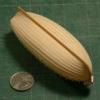-
Posts
13,268 -
Joined
-
Last visited
Content Type
Profiles
Forums
Gallery
Events
Everything posted by druxey
-
The correct plank end detail with the square stern fashion piece is delightful, Chuck!
- 1,051 replies
-
- cheerful
- Syren Ship Model Company
-
(and 1 more)
Tagged with:
-

Is there a better #11 blade handle
druxey replied to roach101761's topic in Modeling tools and Workshop Equipment
A scalpel handle is the only thing for scalpel blades. Tip: use a pair of pliers when changing blades: it's much safer than fingers! -

HMS Alert 1777 by Jaekon Lee - 1/64
druxey replied to Jaekon Lee's topic in - Build logs for subjects built 1751 - 1800
With the rabbeted edge rather than a bevel, how do you transition to the gain fore and aft, Lee? Looks like Lee Valley Tools got you! Very nicely done. -
The quoin is the wedge under the rear of the cannon, Siggi. There were 18 pounder guns cast to the Blomefield pattern that were 8' 0" long, but only after 1787, so that isn't the answer, now that I looked it up!
-
Usually the guns would be secured with the muzzles hard up against the deck clamps, just above the port openings. (The quoins would be removed to do this.)
-
Nice description you hunted down, Ed. So, turpentine was part of the paint formula, but not enough to flatten the finish. Boiling assisted in polymerizing the 'paint oil', which I assume was linseed oil.
- 3,618 replies
-
- young america
- clipper
-
(and 1 more)
Tagged with:
-
With all due respect to Lees and yourself, Dan; Steel (Rigging and Seamanship, Volume I, page 190) gives the sequence of rigging for topgallant masts as shrouds, standing backstay, then stay. Great job on the jib traveller!
-

Silver soldering - Copper vs Brass
druxey replied to rtropp's topic in Metal Work, Soldering and Metal Fittings
That seems strange, Richard. I assume that it really is copper that you have there. Perhaps someone else can suggest what is going wrong. -

Silver soldering - Copper vs Brass
druxey replied to rtropp's topic in Metal Work, Soldering and Metal Fittings
Are all the surfaces clean of all dirt or grease? Are the surfaces in close contact? These are the two most common causes of joint failure. -

ancre Le Fleuron by cabrapente - FINISHED
druxey replied to cabrapente's topic in - Build logs for subjects built 1501 - 1750
You are a brave man: carving those rails already in place!- 332 replies
-
- le fleuron
- 64 gun
-
(and 1 more)
Tagged with:
-
Bee-ootiful, Ed! Your comments on 19th century paint are interesting. I agree that oil based paints dry to a glossy finish, but the addition of turpentine as drying agent will tend to flatten the finish somewhat. Without drying agents in the paint, the film would take weeks if not months to polymerize, i.e. 'dry'. I imagine that the shipyard would have used some turpentine in their paint mix.
- 3,618 replies
-
- young america
- clipper
-
(and 1 more)
Tagged with:
-

Scratch Build George Law rigging question
druxey replied to Boat Doc's topic in Masting, rigging and sails
There are many good books on period rigging. Underhill is certainly one. Another you might consider is Longridge's Cutty Sark. -

to pickle or not pickle, that is the question.
druxey replied to rtropp's topic in Metal Work, Soldering and Metal Fittings
Picking will clean off corrosive flux by-products as well as oxidation on the parts.
About us
Modelshipworld - Advancing Ship Modeling through Research
SSL Secured
Your security is important for us so this Website is SSL-Secured
NRG Mailing Address
Nautical Research Guild
237 South Lincoln Street
Westmont IL, 60559-1917
Model Ship World ® and the MSW logo are Registered Trademarks, and belong to the Nautical Research Guild (United States Patent and Trademark Office: No. 6,929,264 & No. 6,929,274, registered Dec. 20, 2022)
Helpful Links
About the NRG
If you enjoy building ship models that are historically accurate as well as beautiful, then The Nautical Research Guild (NRG) is just right for you.
The Guild is a non-profit educational organization whose mission is to “Advance Ship Modeling Through Research”. We provide support to our members in their efforts to raise the quality of their model ships.
The Nautical Research Guild has published our world-renowned quarterly magazine, The Nautical Research Journal, since 1955. The pages of the Journal are full of articles by accomplished ship modelers who show you how they create those exquisite details on their models, and by maritime historians who show you the correct details to build. The Journal is available in both print and digital editions. Go to the NRG web site (www.thenrg.org) to download a complimentary digital copy of the Journal. The NRG also publishes plan sets, books and compilations of back issues of the Journal and the former Ships in Scale and Model Ship Builder magazines.


